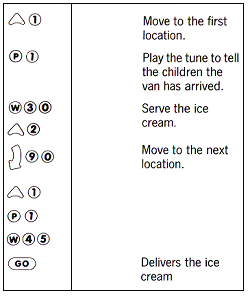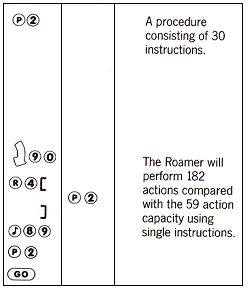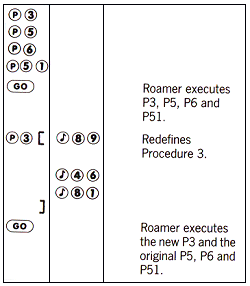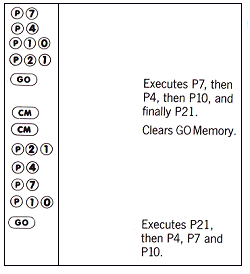
|
Feedback Form
| Introduction | Programming Instructions | Teachers' Section | Looking after your Roamer |
 |
PROGRAMMING ROAMER
The natural response when first meeting a Roamer is to prod a few keys
and see what happens. The Roamer's keyboard, sound cues and simple programming
structure support this exploratory process. With a minimum of teacher
intervention children can achieve remarkable success. They quickly learn
how to make the Roamer move about and make sounds. (Some teachers have
found it useful to mask some of the keys during this early stage.)
The exploratory process can lead to more purposeful work, where children program the Roamer to behave in a particular way; for example, teaching the Roamer to move through an obstacle course.
As their expertise and confidence grows, children are able to tackle more substantial projects. Again, with its 'Repeat' and 'Procedure' facilities, the Roamer supports these developments.

WRITING ROAMER PROGRAMS
It is advisable first to write programs on paper, then to key them into
the Roamer. There are several positive results to be gained from this
discipline:
- It develops planning and thinking skills.
- It develops the important skill of recording information.
- It provides the child and the teacher with a record of their programs and the processes involved in achieving their objectives.
The programming sheet included with your Roamer suggests a technique for writing Roamer programs.
BENEFITS OF USING PROCEDURES
Roamer Procedures have four distinct advantages:
1. Procedures support "Bottom Up" programming
The "Bottom-Up" programming approach is to solve new problems using existing knowledge. If the Roamer has been taught a procedure, it can be used in the performance of new tasks.
For example, suppose that Procedure P1 plays a tune which has previously been taught to the Roamer. A student now wants to use the tune to make the Roamer into an ice cream van.

2. Procedures facilitate "Top Down" problem solving
The "Top Down" approach of dividing a complex problem into smaller, more manageable problems is an important life skill. The Roamer's Procedure facility encourages this approach.
For example, a class project could be divided into group projects. The first group's program is contained in procedure P1, the second group writes P2 and so on. The first group can solve their problem using basic Roamer instructions or procedures P11, P12, P13 .... Group 2 uses procedures P21, P22, P23 etc. The main procedures, Pl, P2 etc., are finally combined in the GO Program.
3. Procedures increase the Roamer's action capacity

4. Procedures simplify the process of changing a program
To change the GO program, the GO memory must be cleared and the whole list must be rekeyed with the modified instructions. If instructions are entered as procedures, only the procedures need to be redefined.



ACTIVITIES USING THE ROAMER
The Roamer Activity Book contains tasks and games for children of different ages and abilities. These ideas use the basic Roamer and do not need any Accessory Packs.
Each activity involves several educationally valuable ideas which children approach through experimentation and exploration. Children playing 'Collecting Rubbish' may use arithmetic, linear and angular measurement, programming, trigonometry and geometry.
The activities should not be used prescriptively. They are starting points around which the teacher may create opportunities for pupils to develop their understanding by testing and revising their own solutions to the problems.
The following case study illustrates this approach:
"Two boys and two girls, from a class of 8 year-olds, played the 'Collecting Rubbish' game from the Roamer Activity Book. They collected a selection of discarded items from the playground and scattered them around the classroom floor. Each child wrote a 'Rubbish Collecting' program. The program was not considered successful unless the Roamer returned, more or less, to its starting point. This involved a process of trial and error. Although the game originally included a competitive element; the children became so absorbed that they began to help each other.
The children had to estimate distances and angles. They used words like "perimeter" in the correct context. As their understanding of these ideas grew, their game strategies became more efficient.
An interesting development began when children decided which type of litter to collect. Each child wrote a program to collect a particular type of rubbish. The other children had to guess the rationale behind the selection. One child programmed the Roamer around items that "would go rotten". The children disagreed with some of his selections so it was decided to conduct experiments to discover what would rot.
Other children selected paper objects or food containers. One child selected large objects, partly because it was easier to drive the Roamer around them. She justified her choice by saying, "They covered more area."
During discussions afterwards, one child noticed the similarity between selecting objects in this way and formal Uenn diagrams. The children fitted the Roamer with a pen and drew lines around the different sets.
The mathematical links were obvious. What was surprising was the interest the children developed in litter. The Roamer caught their imagination. Because they were actively 'doing', the topic was approached at the correct level for their understanding. Their interest grew and they wanted to help other children realise the wider ecological issues involved."
Alan Coode, Headteacher, Southmead Junior School, South London.
ROAMER CONTROL FEATURES
You can expand the Roamer's range of activities with a Roamer Control Box. This provides the Roamer with a Sense Input Line, four Two-State Outputs and a Stepper Motor Output. They are controlled by the following keys:
- 'S'
- for Sense
- 'T'
- for the Two-State Outputs
- 'M'
- for Stepper Motor.
The instructions on how to program with these keys are supplied with the Roamer Control Box.
Connecting sensors and motors greatly extends the scope for Roamer characterisation. 'Mophead' the Roamer guard dog could be programmed to prick up its ears and bark when it hears a sound. 'Fiona' the Fire Engine could flash her light, raise her ladder and play her siren. The Roamer Bee could flap its wings and hum "Flight of the Bumble Bee".
Roamers can be programmed to respond to light, sound, touch, temperature, etc.. The motors can be used to raise and lower a pen, operate a robot arm, raise a flag, stir a cup of tea or even play cricket. If the child can think of it, the Roamer can probably do it.